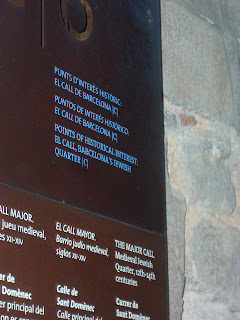 On our field trip to El Born and La Ribera, it was interesting to see how the area has transformed in recent years to become one of the trendiest neighborhoods in Barcelona. El Born is La Ribera's neighborhood within a neighborhood. The centerpiece of El Born is the Santa Maria del Mar church, which faces onto a beautiful square with wine and tapas bars. Known as the People's Cathedral, this is one of the most popular and frequently visited religious centers. Built in the fourteenth century, both the exterior and interior have been wonderfully preserved. Also, the stained glass windows are beautiful. At the back of the church is the area's main street, Paseo del Born, which is lined with cosy bars and restaurants. This small, intimate, and friendly neighborhood is where just about everything fashionable is happening now such as art, clothes design, interior decoration, etc.
On our field trip to El Born and La Ribera, it was interesting to see how the area has transformed in recent years to become one of the trendiest neighborhoods in Barcelona. El Born is La Ribera's neighborhood within a neighborhood. The centerpiece of El Born is the Santa Maria del Mar church, which faces onto a beautiful square with wine and tapas bars. Known as the People's Cathedral, this is one of the most popular and frequently visited religious centers. Built in the fourteenth century, both the exterior and interior have been wonderfully preserved. Also, the stained glass windows are beautiful. At the back of the church is the area's main street, Paseo del Born, which is lined with cosy bars and restaurants. This small, intimate, and friendly neighborhood is where just about everything fashionable is happening now such as art, clothes design, interior decoration, etc.
The heart and soul of this community is the wide open Passeig del Born. From the thirteenth to the seventeenth centuries, this was pretty much the main square of Barcelona where public festivities and other events were held. Although the Boqueria on Las Ramblas may be the city's most famous food market, the main wholesale business was always done here at El Born. The textile museum is located in this area because in Born's early days it was home to the textile guilds of Barcelona. Guilds were a forerunner to the trade unions and the backbone of Barcelona medieval life. Many of the shields can be seen on buildings dotted around the Barri Gotic, which would have denoted the headquarters of each particular trade. El Call, the original Jewish ghetto, is also located within the Barri Gotic. The recently refurbished La Llotja, the city's first stock exchange, lies on it outer edge on the Placa Palau.
No comments:
Post a Comment